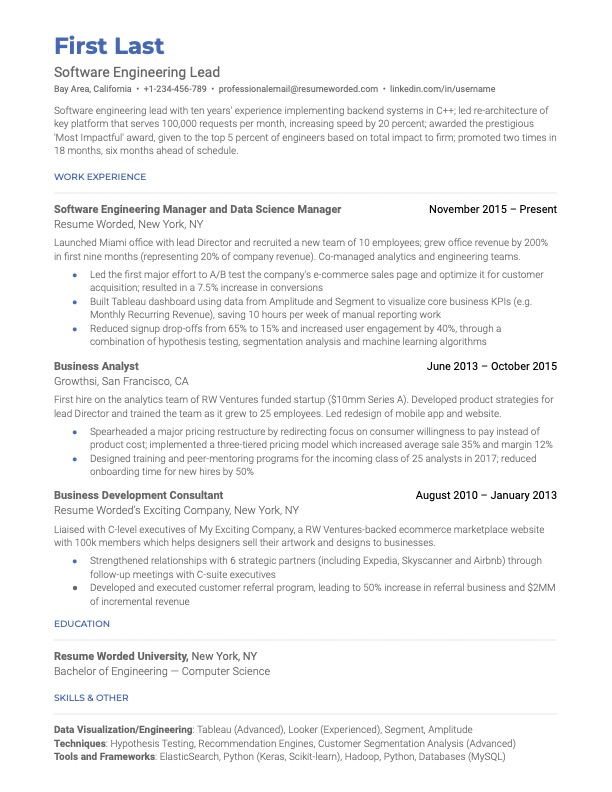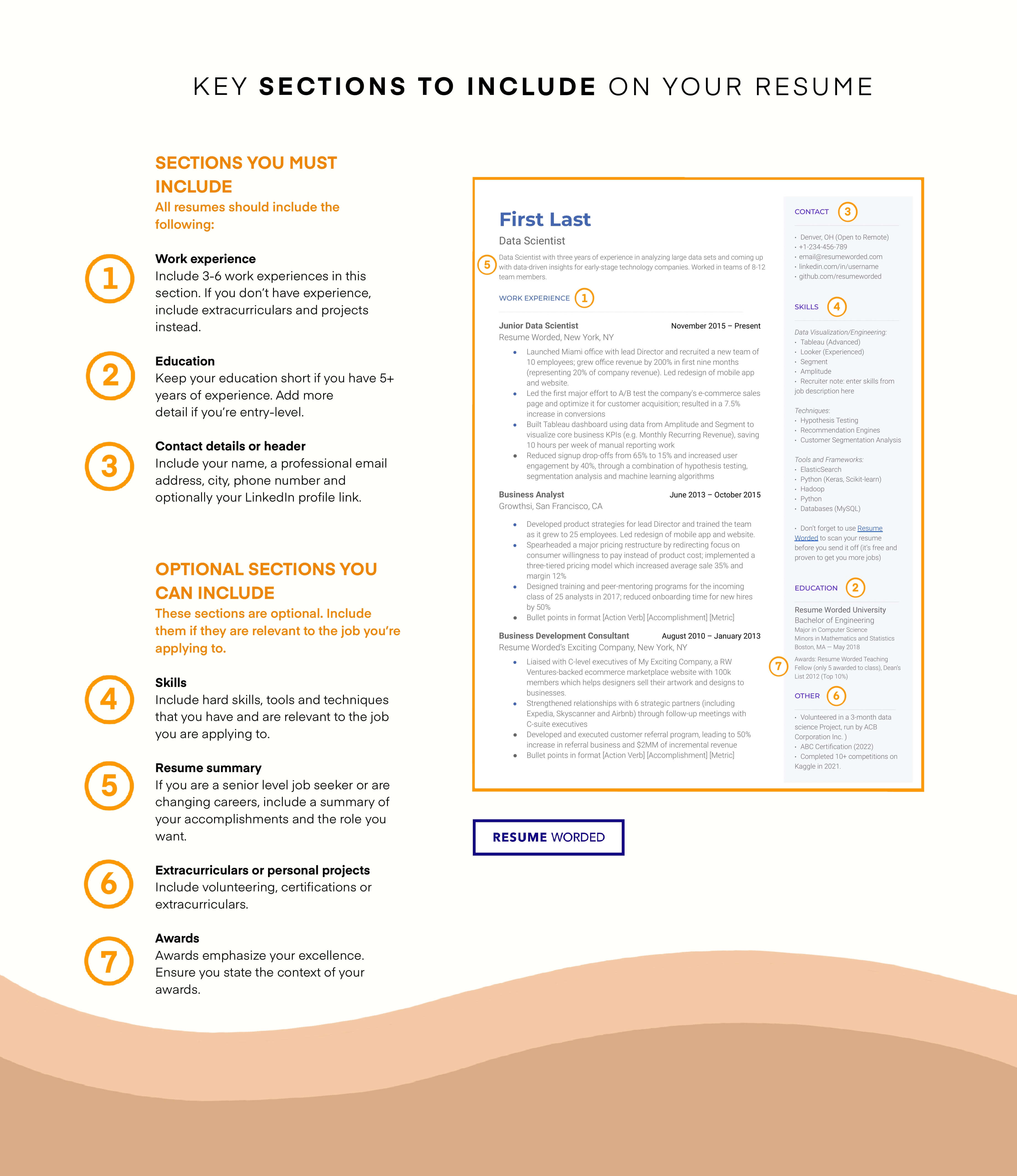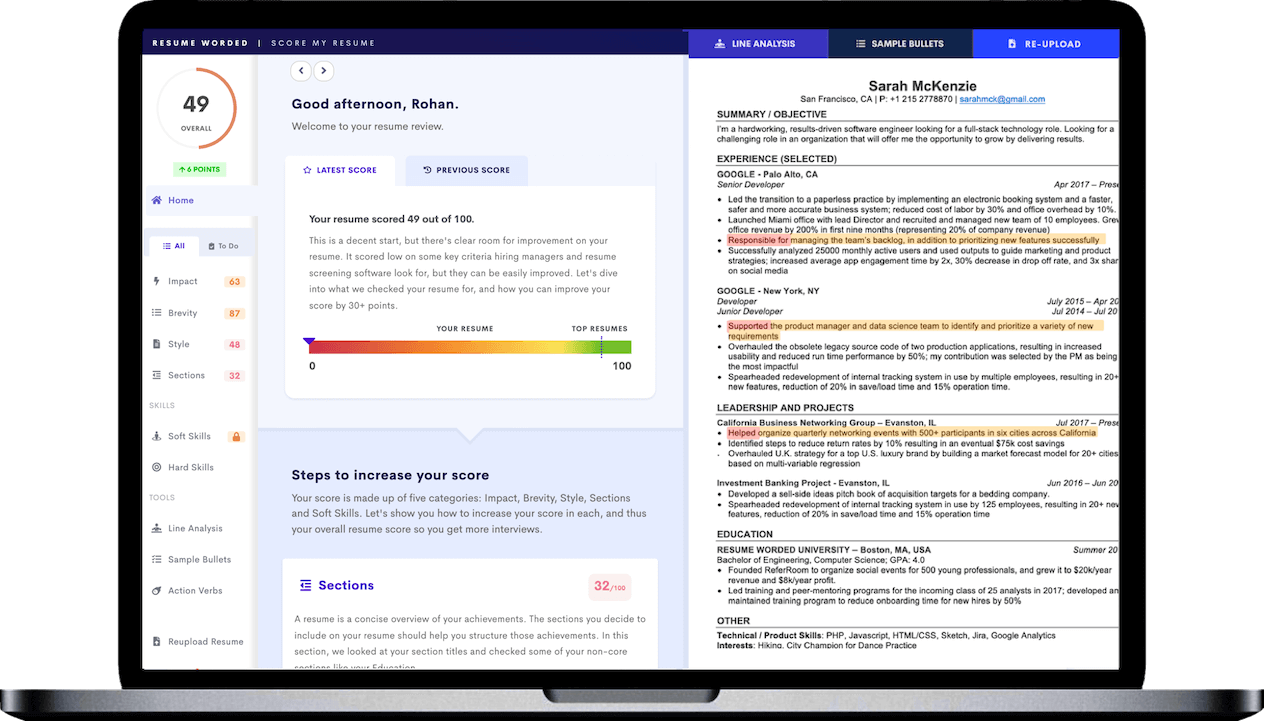When writing a resume, it can be difficult to know where to begin. Should you put your education or work experience first? What about skills? And why does it even matter, as long as all the necessary information is on there somewhere?
We’ll give you simple answers to all those questions below — but let’s start with that last one.
Why resume order matters in 2024
Putting things in the right order on your resume isn’t just a matter of convention — it serves a few practical purposes, too. The order of sections on your resume impacts:
- Readability. Putting things where recruiters expect to find them means they’ll be able to get more information from your resume quickly — which means you’re more likely to stay in the running past an initial resume screen.
- Applicant Tracking Systems. Most companies now use some form of ATS, which has affected best practices for resume writing. Ordering your sections in a simple, straightforward manner is the best way to keep it ATS-compatible.
- First impressions. Like it or not, some resume conventions do matter, and this is one of them. Using a standard resume section order shows that you understand professional norms.
The easiest way to make sure everything on your resume is in the right order is to run it through a free resume checker. Score My Resume can provide instant feedback on resume section order as well as overall style and brevity.
The best order for work experience on your resume
Speaking of resume conventions, you may have heard about different chronological vs hybrid vs functional vs skills-based resumes. While a lot of different resume gimmicks have come and gone over the years, the truth is still that reverse chronological order is the best resume format.
This means you should list your most recent job at the top of your work experience section, followed by any previous jobs from newest to oldest. There are a lot of reasons for this (like the ones listed above - readability, ATS, and first impressions), but the most important one is that the recency of your experience directly affects how relevant it is, and the most relevant information should always go at the top of your resume.
How to organize your resume sections
Now that that’s covered — what order should your resume sections be in? This depends a bit on where you are in your career, but in general, you should expect to list your work experience first, followed by your education, skills, and other information.
Here’s an example of a well-organized resume that works for just about any job seeker:

You can download this template — or browse 350+ others — at our ATS resume templates page.
For most job seekers
In most cases, the correct order of resume section is:
- Contact information. Always start with your name, phone number, and email address so hiring managers know who the resume belongs to and how to get in touch with you if they want to move you forward.
- Resume summary. A summary statement provides a quick snapshot of your professional identity, key accomplishments, and career objectives.
- Work experience. This is the core of your resume and should be prominently located. A clearly formatted work experience section (see above) allows hiring managers to quickly review your past experience and relevant accomplishments.
- Education. This should still be on your resume even if you’re not a recent graduate, but below your work experience —you can even remove the dates if you graduated 8+ years ago.
- Skills and certifications. This should be a short section at the bottom of your resume. It can include specific hard skills, professional certifications, and other information like personal projects and volunteer work.
This is the most standard resume section order, which means it’s just as appropriate for recent grads as for 20-year industry veterans. That said, if you want a little more customization in your resume, here’s how to optimize it for different stages of your career.
For recent graduates
The best order for recent grads is only slightly different — in this case, you should put your education at the top. Your resume should look something like:
- Contact information.
- Education. If you’re still in school or only graduated recently, your education is probably your strongest asset, so make sure to showcase it upfront.
- Work Experience. This can also include part-time jobs, internships, volunteer work, or work study.
- Activities. If you have a lot of awards or extracurriculars, consider creating a separate section where you can highlight soft skills like teamwork and leadership.
- Skills. If you’re not sure what skills you should be highlighting, try searching for your desired role or industry in our skills and keywords database.
Want more options? Here are 50+ entry-level resume templates to get you started.
For career changers
Career change resumes can differ in a few ways, but the main one is that you might want to split your work experience into two sections. Here’s how that might look:
- Contact information.
- Resume summary. This is your chance to provide some context for why you’re changing careers and why your background is a good fit — even if it doesn’t appear that way at first glance.
- Skills. Usually, these should go at the end of your resume, but by moving them up you can show hiring managers that you have the necessary background for the role.
- Relevant experience. It’s always better to put more relevant experience first, even if it’s a little older.
- Additional experience. Here’s where you can list any other recent jobs that aren’t directly relevant to your new career path.
- Education. You should still list your qualifications even if they’re not in the same field.
For even more advice on how to make a successful career change,check out the career change tag on our blog.
For senior-level candidates
If you’re applying for higher-level roles, including management or C-suite positions, it stands to reason that your resume should go into a little more detail. Here’s how to structure that:
- Contact information.
- Resume summary. If you’ve had to cut down your work experience, this is also a good place to put career highlights, even if they’re a little older.
- Work experience. This can go back a little further than the usual 10-15 years if you’re applying for more senior roles and should showcase professional advancement.
- Professional organizations and community involvement. For higher-level roles, it’s a good idea to include anything that establishes you as a leader in your field, like board membership or involvement with professional organizations in your industry.
- Education. No matter how long ago it was, your educational qualifications should stay on your resume (but it’s okay to remove the dates).
- Skills and certifications. Another key difference is that your resume can be a little longer if you’re applying for senior or executive positions — think two pages instead of one. For more insights, head over to our definitive guide on how to write an executive resume.
FAQ
If I switch the order on my resume, will it look like I'm hiding something?
Indeed, it can. If your resume is not organized in a straightforward way, it could give employers the impression that you're attempting to obscure certain aspects of your career history.
Can a poorly ordered resume hurt my chances of getting a job?
Unfortunately, yes. A resume that's confusing or disorganized can make recruiters' jobs more difficult, increasing the likelihood that yours might be put aside. Keep it clear, concise, and well-ordered to show you're the organized professional they need.
Does the order of a resume differ depending on the type of job I'm applying for?
Absolutely! Your resume should be a living document that changes based on the role you're aiming for. Applying for a tech job? Highlight your related skills and projects up top. Going for a management position? Make sure your leadership experiences take center stage. Keep the job description handy when you're deciding on your resume's order.
Are there cultural or regional differences in preferred resume order that I should be aware of?
Good catch! Yes, different countries have different conventions. For example, some countries prefer personal details like age and marital status at the top of a resume (though that's typically not the case in the U.S.). Always research resume norms for the country where you're applying.
Does the order of a resume differ for entry-level versus senior-level roles?
It does. For entry-level roles, your educational achievements might take prime real estate on your resume. For senior-level roles, a detailed account of your professional trajectory becomes more important. The golden rule? Highlight what's most relevant and impressive based on where you're at in your career.
Where should I place my personal projects, volunteer work, or other non-traditional experiences on my resume?
These can be a valuable part of your resume, especially if they showcase relevant skills or experiences. Typically, they can go in a section towards the bottom of your resume, after your formal work experience and education. However, if these activities are particularly relevant to the job you're applying for, you might decide to position them more prominently.










